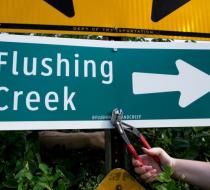How do you get to Flushing Creek? Favorite
Flushing Creek is so hidden by industrial sites and highways, it’s almost invisible to those passing through the Flushing neighborhood of Queens. “I lived in Flushing my whole life and didn’t know that I lived near waterways until I was 20 years old,” Cody Ann Herrmann told Hyperallergic. Now the artist and community organizer is advocating for its visibility through the “How do you get to Flushing Creek?” project, a multiyear initiative involving conversations on the street, a zine with maps, and guerrilla signage.
“If you’re not seeing the problem, you don’t really take ownership or stewardship over it,” said Herrmann, who is currently in the Social Practice Queens MFA program at Queens College. For the July 14 City of Water Day, organized by the Waterfront Alliance, several aluminum signs were covertly installed in Flushing and Willets Point. Each pointed the way to Flushing Creek.
Supported by the New York-New Jersey Harbor & Estuary Program and Guardians of Flushing Bay, these wayfinding tools matched the official signage, while adding directions that had long been absent. Herrmann didn’t expect these unsanctioned signs to stay up forever (indeed, one has already been removed). Instead, she saw them as a chance to start dialogues with local stakeholders. They were installed on existing street sign posts at sites overseen by entities engaged in the future of Flushing Creek, such as the Department of Transportation, Parks Department, and SkyView Center mall.
This waterway which flows through Flushing-Meadows Corona Park and empties into the East River has been polluted by decades of industrial waste, and its sewage overflows continue to be fatal to fish. The site even had an infamous turn in F. Scott Fitzgerald’s 1925 The Great Gatsby as the “valley of ashes,” a smoldering landscape where the Brooklyn Ash Removal had turned the waterway’s salt marshes into toxic landfill. Part of the creek was later filled in for the 1964 World’s Fair, while roads and businesses constructed around it in the 20th century further blocked public access to the shore (aside from the sporadic park, like the Willow Lake Preserve).
Now, major redevelopment is planned for the land alongside Flushing Creek, including a $3 billion construction project at Willets Point. “Really every section of the Flushing waterway is being molded into something else right now,” Herrmann stated. “The shorelines are being redesigned, the access is changing. You have Willets Point on one side of Flushing Creek, and you have Flushing on the other side. Billions of dollars are being pumped into them, and when is this money going to meet in the middle? Because the middle is Flushing Creek.”
Before installing the signs, Herrmann created a small zine with a map of eight routes to the waterfront. One is through a U-Haul parking lot, another through a hole in a fence, and another is under the Van Wyck Expressway. The zine includes her transcripts of conversations with locals. She walked around downtown Flushing and asked people how to get to Flushing Creek. Mostly they hadn’t heard of it, and sometimes didn’t believe it was there. These publications were distributed in holders next to the Flushing Creek signs, as well as in Flushing’s Little Free Library outside the Flushing Meeting House.
“How do you get to Flushing Creek?” is ongoing, with Herrmann updating its dedicated Instagram — @FlushingBayandCreep — with photographs of Flushing waterways and advocacy efforts and news. Rivers, creeks, and estuaries are not as central to daily life in New York as they once were for the seaport city. Nevertheless, from the Gowanus Canal to Newtown Creek, and the shores of the East River, a rapid rate of development is transforming these long-neglected sites.
“This story about access is not in any way unique to Flushing,” Herrmann affirmed. She added that the project is ultimately an “effort to get people to explore and make mistakes and play with their neighborhood, and maybe walk through the wrong gate where you might find something new and different instead. It’s putting people in vulnerable situations where you think you know a place, and it totally puts you on your head.”







